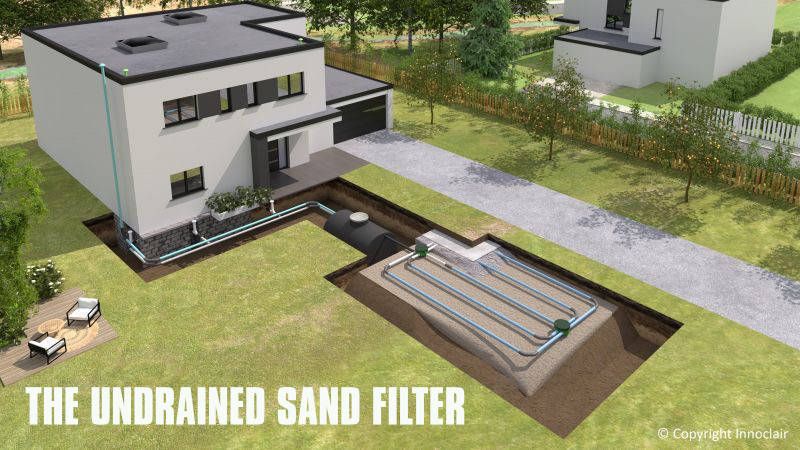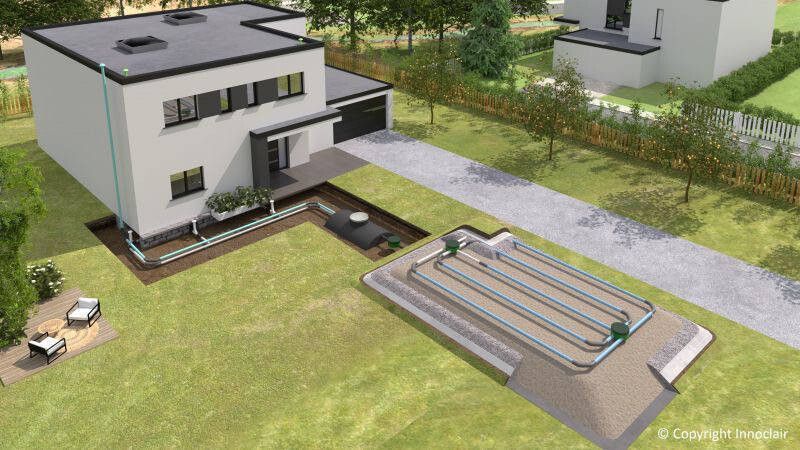Soil treatments
What types of solutions are used in the traditional systems? The devices of treatment by the ground also called "the traditional dies" are composed of 3 types of solutions.
The common point of these 3 approaches is that their installation will depend on the nature of the ground and that they require important surfaces: from 30 to 200 m² according to the solution and the number of inhabitants.
THE DIFFERENT TYPES OF SOIL TREATMENT
There are 3 types of soil treatment systems:
Composition of a soil treatment system:
- Upstream of these 3 devices, you will find an all-water tank (AWT) more commonly called "septic tank".
- All the grey and black water from the house (WC, washbasin, sink, shower and bathtub) are evacuated towards the all water tank to be pre-treated.
- The final treatment is carried out using one of the systems mentioned above: trench sewer, sand filter or infiltration mound.
The wastewater from the house is stored in an all-water tank (AWT) also called a septic tank.
This all-water tank ensures the pre-treatment of wastewater.
Characteristics of the land
This device is one of the most used in non collective sanitation but it imposes 2 conditions:
- The ground must be sufficiently permeable.
- The available surface must be relatively important between 150 and 200 m².
Characteristics of the soil
In order for the filtration and purification to be done in good conditions, the soil must have the following technical characteristics
- Physico-chemical characteristics allowing a good micro-organic functioning (presence of oxygen).
- A permeability adapted to its flow.
- An absence of water rising.
Soil study by an engineering and design department
That is why, to know all this information and to be sure that the conditions are respected, you must call upon a research department which will carry out a soil study.
Conditions for land application
The spreading of wastewater is then carried out at a shallow depth and spread over several trenches. Each trench cannot be more than 30 m long. In general, under normal conditions, 15 linear meters per inhabitant are required. For 6 population equivalents (6 p.e.), 90 linear meters of trenches are required.
ADVANTAGES
-
It is the "first price" device on the market of autonomous sanitation (in first analysis).
DISADVANTAGES
-
It is not a compact system and requires a lot of space.
-
Few plots of land are suitable for its implementation, which is quite strict.
Summary
- Although it is the "first price" of the devices, the bill is often more expensive in the end because the installer's constraints are much more important and the necessary ground surface is much more consequent.
- It is essential to play the competition by obtaining comparative quotes from several installers.
- Need a list of diggers near you? Click here for a list

2. SAND FILTERS OR FILTER BEDS
The wastewater from the house is stored in an all-water tank (AWT) also called a septic tank. This tank performs the pre-treatment of the wastewater.
The final treatment of the wastewater takes place in the sand filter. The purification of the wastewater is achieved by the micro-organisms fixed on the sand.
Installation work
The professionals replace the natural soil with a reconstituted soil of washed silica sand and gravel. The whole system is then covered with about 20 cm of topsoil. An anti-contaminant film (a tarp) is installed between the sand and the soil. This allows water and air to pass through.
Sand filters are made up of sand and gravel, and allow wastewater to be treated before being discharged into the natural environment, freeing it of any polluting or environmentally harmful substances.
The wastewater is first treated in the gravel part and finishes its treatment in the finest part made of sand.
You will choose the type of filter used according to your land and its characteristics:
- Soil permeability.
- Protection of the water table.
- Available ground surface, etc...
The engineering and design department that you have commissioned to carry out your soil study will be able to tell you what type of sand filter to install. There are different types of sand filters:
Horizontal sand filters
This technique is rarely used because of the irregularity of its results. It is similar to a platform dug into the ground. The wastewater from the house will be stored and pre-treated upstream in the all-water tank (i.e. the septic tank). Then, this water will be sent to a distribution manhole which will distribute it evenly in the filter. This pre-treated water will then pass through different layers of sand and gravel. This technique will allow to purify the wastewater and to reject the treated water in the natural environment.
The vertical sand filter
This filter does not consist of a platform but of several trenches. It can be of 2 types:
- The drained vertical sand filter.
- The non-drained vertical sand filter.
In both cases, the draining part must be composed of a minimum thickness of 70 cm of gravel and sand. The difference between these 2 filters is in the bottom of the trenches. In the case of the drained sand filter, a network of pipes allows the treated water to be recovered and evacuated to a ditch for example. The treated water from the non-drained filter will infiltrate deep into the ground. A sand filter requires 5m² per inhabitant equivalent, i.e. between 20 and 35 m² per house.
ADVANTAGES
-
Takes up less space than trenches.
DISADVANTAGES
-
Difficult to implement due to the risk of perforation of the tarp (and therefore risk of non-compliance).
-
More expensive than trench systems.
-
Constraining since no plantation, road or building can be installed above the filter.
-
The law will soon force an expensive recycling of the sand at the end of the filter's life.


3. INFILTRATION MOUNDS
This is the only system in this category that can be installed in wetlands and if the soil is not suitable for spreading. More expensive, it will require a surface of 60 to 120 m² in a mound of about 1m high.
Upstream, the wastewater from the house is stored in an all-water tank (AWT) also called a septic tank.
Downstream, an infiltration mound takes care of the treatment and the discharge of the treated water.
The infiltration mound is similar to a vertical sand filter, but above the ground instead of inside. An infiltration mound will often be installed if:
- The house is located in a flood zone,
- a water table is close to the installation,
the soil is rocky, - the soil cannot be used for conventional sewage treatment (e.g. trench sewage treatment).
 The infiltration mound can be partially or completely above ground. It is often located at the bottom of the plot and takes the form of a sandy bed raised above the rest of the garden. In other words, you will have a mound of earth at the bottom of your garden.
The infiltration mound can be partially or completely above ground. It is often located at the bottom of the plot and takes the form of a sandy bed raised above the rest of the garden. In other words, you will have a mound of earth at the bottom of your garden.
The wastewater stored in the all-water tank (AWT) will then be conveyed to the infiltration mound with the help of a lifting station. Thanks to this pump, the wastewater can "rise" to the top of the mound. Note: the installation of a lifting station is not necessary if the slope between the cesspool and the mound is sufficient. The wastewater to be treated will then be distributed in the mound with the help of spreading pipes. The wastewater is then treated by passing from layer to layer, from the coarsest layer of gravsel to the finest layer of sand. These layers are distributed from top to bottom. At the bottom of the mound, the treated wastewater is discharged into the natural environment.
ADVANTAGES
-
Can be installed in wetlands if regulations are respected.
DISADVANTAGES
-
Unsightly. You have to think about the loss of real estate value if the house is resold.
-
Costly to install.
-
Delicate aging (rodents, etc.)
-
Requires a large surface area: a mound has a larger surface area at its base than at its top. At its top, a mound measures between 20 and 30 m² depending on the number of equivalent inhabitants (eh). At its base, the surface area varies from 60 m² for the smallest mounds to 120 m² for the largest mounds (its surface area at the base always depends on the number of equivalent inhabitants and the type of soil). Count on a height of about 1 m for all the mounds.


We are able to ensure the after-sales service and maintenance of the sanitation systems of:
-
Individuals.
-
Hotels, campsites, leisure parks, holiday centres.
-
Breweries & Restaurants.
-
Castles & charming houses.
-
Food production companies.
-
Wine growing companies.



 FR
FR